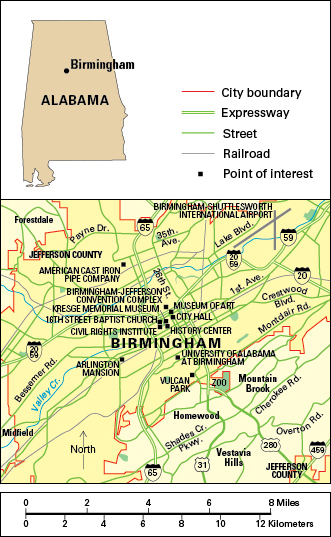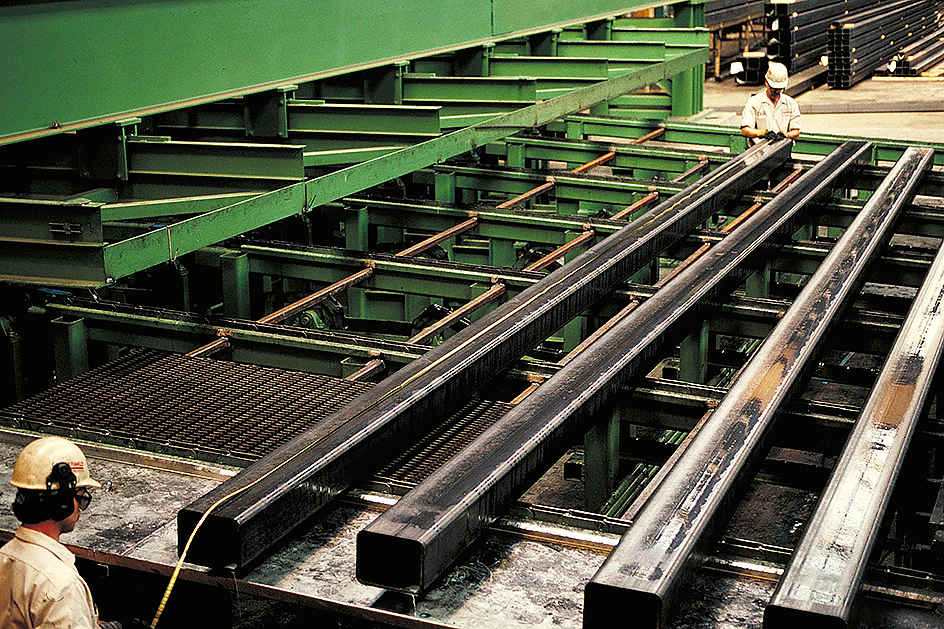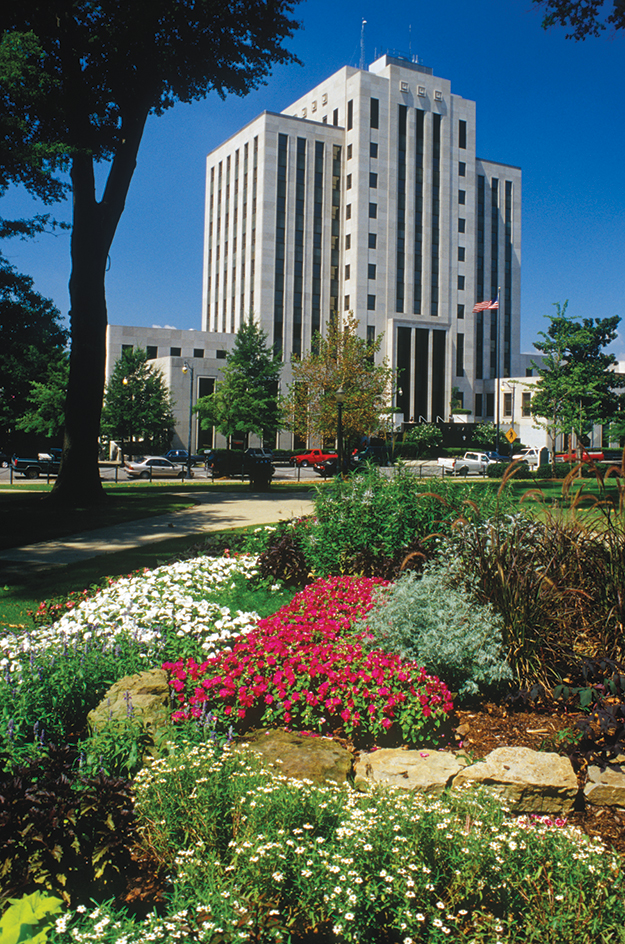Birmingham << BUR mihng `ham` >> (pop. 200,733; met. area pop. 1,180,631) is one of the largest cities in Alabama and a leading steelmaking, educational, and medical center. Birmingham lies in Jones Valley at the foot of Red Mountain in north-central Alabama.
The rich land of Jones Valley contains all three major ingredients of steel—coal, iron ore, and limestone. In 1870, two railroads completed tracks leading into the valley. The Elyton Land Company, a group of bankers and investors, helped found Birmingham in 1871 at the place where the railroads met. The group named the community for the large English steel-producing city of Birmingham.
The city.
Birmingham, the county seat of Jefferson County, covers 150 square miles (387 square kilometers). The metropolitan area consists of Bibb, Blount, Chilton, Jefferson, St. Clair, Shelby, and Walker counties—an area of 5,370 square miles (13,907 square kilometers). The city’s central business district occupies the area around First Avenue and 20th Street North. The University of Alabama at Birmingham (UAB), including the UAB Medical Center District, lies south of the financial district. Residential neighborhoods lie chiefly in the eastern and southern parts. For the monthly weather in Birmingham, see Alabama (Climate). 
Almost all of the city’s people were born in the United States. African Americans make up about 70 percent of the city’s population and 30 percent of the metropolitan area’s population.
Economy.
The steel industry plays a major role in the economy of the Birmingham area. But since the mid-1940’s, the area’s economy has depended less on steel production. Employment in the medical and health fields has grown greatly since the UAB Hospital opened in 1945. UAB is Birmingham’s largest employer. The telecommunications industry also has much importance in the economy.

Metropolitan Birmingham has hundreds of manufacturing firms. They produce chemicals, cast-iron pipe, and transportation equipment, as well as iron and steel. Other industries include banking, publishing, and food processing.
Airlines, passenger railroad trains, and interstate highways connect Birmingham to other cities. A number of railroad freight lines and truck lines serve the city. Docks on the Warrior River, 20 miles (32 kilometers) west of Birmingham, provide a water link with the Tennessee-Tombigbee Waterway system and the port of Mobile, Alabama.
The city’s main newspaper is The Birmingham News. Several television and radio stations broadcast in the city.
Education and cultural life.
Birmingham’s public school system includes elementary schools, middle schools, and high schools. The city also has dozens of private and parochial schools. In addition to UAB, colleges and universities in the area include Miles College and Samford University. Birmingham’s public library system consists of a central library and branches throughout the city.
The Birmingham Museum of Art owns part of the Kress collection of Italian paintings. The city has a symphony orchestra, a civic opera, a ballet company, and a number of theater groups.
Birmingham has an extensive system of public parks. The largest cast-iron statue in the world, Vulcan, stands 56 feet (17 meters) high in Vulcan Park on Red Mountain. This statue represents the Roman god of fire and metalworking. The Birmingham Zoo ranks as one of the largest zoos in the Southeast. A Birmingham mansion called Arlington, built during the late 1840’s, is open to the public.
Government.
Birmingham has a mayor-council form of government. The mayor serves as the administrative head of the government. The voters elect the mayor to a four-year term. Birmingham has nine city council members, also elected to four-year terms. The elections for mayor are spaced two years apart from elections for city council members. Birmingham gets most of its revenue from business license fees, sales tax, and other taxes.
History.
Cherokee, Choctaw, and Muscogee, or Creek, peoples hunted in Jones Valley before white settlers came to the area. The first white settlement there occurred in 1813. During the American Civil War (1861-1865), small ironworks were built in Jones Valley. By 1870, the area’s mineral riches had attracted two railroads. Birmingham was founded in 1871 at the junction of the railroads and was incorporated as a city later that same year. 
Birmingham grew rapidly, but in 1873, a cholera epidemic and a national business panic almost destroyed the new community. Then, in 1880, Alabama’s first blast furnace began operating in Birmingham. The city’s industries expanded as the 1880’s brought increased demands for iron. The population grew so quickly—from 3,086 in 1880 to 132,685 in 1910—that Birmingham got the nickname of the Magic City.
The nation’s demand for iron and steel declined after the Great Depression began in 1929. Birmingham became one of the hardest-hit areas in the country during the Depression. Prosperity finally returned to Birmingham when World War II (1939-1945) brought new demands for steel. During the late 1940’s and the 1950’s, Birmingham became one of the South’s leading industrial centers.
In 1963, Black people and white people clashed in Birmingham over the issue of racial integration. The tension increased, and President John F. Kennedy sent federal officials into the area to help settle differences. Later that year, a bomb exploded in a Black church, killing four Black girls. Interracial groups then organized and began working to prevent further trouble.
A period of new construction began in Birmingham during the late 1960’s. The Birmingham-Jefferson Civic Center (now called the Birmingham-Jefferson Convention Complex) opened in 1976. It includes an arena, concert and exhibition halls, and a theater. It was expanded in 1992 to include a conference facility and a 770-room hotel. The UAB medical center opened several research and treatment facilities in the late 1970’s, the 1980’s, and the 1990’s.
The 34-story SouthTrust Building (now Shipt Tower), one of Alabama’s tallest office buildings, was completed in downtown Birmingham in 1986. The huge headquarters building of the Alabama Power Company was also completed in 1986.
Birmingham’s population, like that of many other cities, declined from the 1970’s through the first two decades of the 2000’s. But the population of the metropolitan area increased, as many white residents moved from the city to the suburbs.
In 1979, the voters elected Richard Arrington, Jr., as Birmingham’s first Black mayor. In 1985, Black councilors gained a majority on the city council for the first time. Arrington was reelected four times. He retired in 1999.
In April 2011, a series of powerful tornadoes struck Alabama, causing much death and destruction. About 45 people in the Birmingham area were killed.
See also 16th Street Baptist Church bombing.
